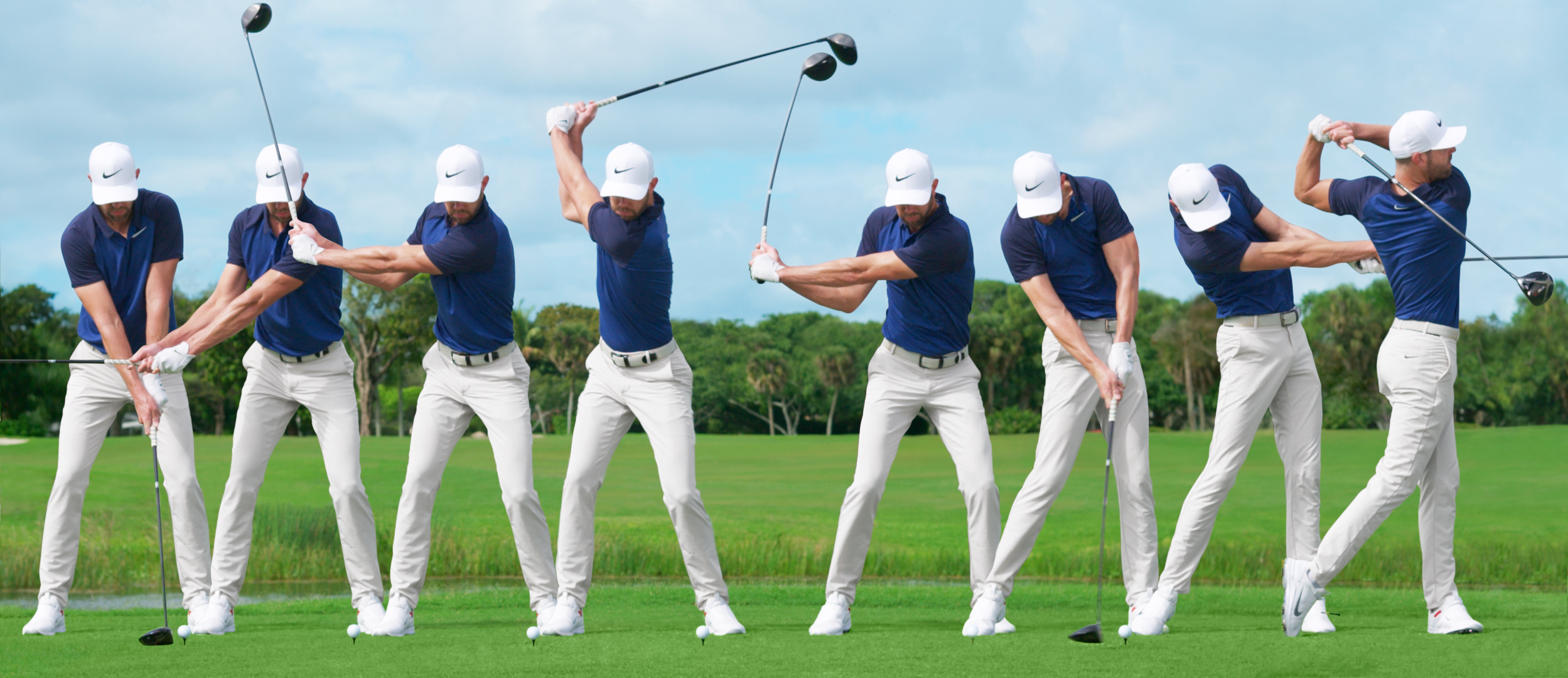- You know that to improve your swing you won't do it with 5 easy steps or tricks like everyone is saying out there.
- There are no shortcuts, golf is NOT easy. You need to grab your bag and get your ass to your nearest practice area. In the meantime, here is a collection of 9 good tips:
Balance and stability in the swing
When it comes to golf, one of the key elements you need to focus on is achieving balance and stability in your swing. The first step to achieving this is to ensure that your stance is solid and evenly distributed. This means placing your feet shoulder-width apart and keeping a slight bend in your knees. It is also crucial to distribute your body weight evenly across both feet. This way, you create a strong and stable base from which to execute your swing, allowing you better control and consistency in your shots.
Another key aspect of achieving balance is focusing on body alignment throughout the entire swing. This involves keeping your head, shoulders, hips, and feet aligned with the intended line of the shot. Additionally, maintaining a firm, unwavering focus on the ball, even after hitting it, is essential for a well-balanced and controlled swing. This helps your body movement to be smooth and coordinated, ultimately leading to more consistent and accurate results on the course.
Additionally, the role of core strength in achieving balance and stability cannot be underestimated. Engaging your core muscles is vital in providing the necessary support and control to your movements. Therefore, incorporating core strengthening exercises into your workout routine can greatly contribute to developing a stable and balanced swing.
It is also important to note that mental focus and clarity play a major role in achieving balance and stability. By maintaining a calm and focused attitude, you will be able to better attune your body to the smooth, controlled movements necessary for a successful swing, free of unnecessary tension or imbalance.
Improve your hip rotation
Improving your hip rotation is a crucial factor in optimizing your golf swing technique. Proper hip rotation not only contributes to the power and distance of your shots, but also plays a vital role in maintaining the overall fluidity and coordination of your swing.
An effective method for improving hip rotation is to focus on coiling the upper body against a stable lower body during the backswing. This separation of the upper and lower body allows for a greater range of motion at the hips and lays the foundation for a more dynamic and powerful downswing. Additionally, practicing hip flexibility exercises can significantly help achieve full, uninterrupted rotation, which is essential for generating maximum torque and ball speed at impact.
Additionally, it is beneficial to emphasize the correct sequencing of hip rotation within the full swing motion. This involves initiating the downswing with a shift of the lower body, followed by a progressive and synchronized rotation of the hips toward the target. By perfecting this sequential hip movement, you can ensure that the transfer of energy from your body to the club is optimized, resulting in a more consistent and powerful ability to hit the ball.
Incorporating specific exercises and drills into your training program, such as lateral hip shifts and rotational strength exercises, can promote the development of fluid and efficient hip rotation, ultimately leading to improved overall swing performance.
Strengthen your legs
Building strength in the lower body is essential to supporting a stable and powerful golf swing. The legs act as the foundation from which the rest of the body generates force and propulsion, making leg strength a key component of a complete swing technique.
An effective way to strengthen your legs is to incorporate exercises that target your quads, hamstrings, glutes, and calf muscles. These can include squats, lunges, deadlifts, and calf raises, all of which contribute to building the strength and stability needed for a solid, controlled lower body during the swing.
Additionally, participating in activities such as walking, hiking, or biking can also serve as valuable low-impact forms of conditioning for the legs, helping to improve endurance and overall muscle support for the demands of the golf swing. If golfers consistently train and strengthen their lower body, they can experience increased stability, balance, and power in their swing, which translates into more effective and consistent performance on the course.
It is important to approach leg strengthening as a complementary element of your overall golf fitness and training routine, as strong, stable legs are the foundation for a controlled, powerful swing and for preventing injuries related to the repetitive nature of the golf swing.
Align your legs
Ensuring that your legs are correctly positioned and engaged throughout the swing process is essential to maintaining stability and generating power. One area to focus on is the alignment and position of your knees, as they play a vital role in supporting the transfer of energy and force through the lower body during the swing.
Proper knee position involves maintaining a slight bend in both knees at the start position and throughout the swing, which helps promote agility, balance, and a smooth weight transfer. Additionally, paying attention to the distribution of pressure on the feet, especially the instep, can help maintain a solid, rooted base from which to initiate and execute the swing with stability and control.
Additionally, correcting any imbalances or weaknesses in the legs through physical therapy or specific corrective exercises can greatly contribute to improving overall lower body stability and strength during the golf swing. By ensuring that the legs are functioning optimally and unhindered, golfers can experience a smoother and more powerful transfer of energy from the ground upwards, resulting in improved swing performance and consistency.
Correct your posture with wall exercises
Improper posture can significantly impede the quality and consistency of your golf swing. An effective way to address and correct posture issues is through specific exercises using a wall as a visual and tactile guide. By standing with your back to the wall, you can actively work to align your spine, shoulders and hips in the optimal position for a balanced and well-executed swing.
Wall drills also give you the opportunity to practice maintaining proper distance from the ball, as well as establishing the feeling of a straight, neutral spine angle. Additionally, incorporating rotational drills against the wall can help cultivate smooth, coordinated upper body rotation while maintaining a stable lower base, which encourages a more consistent and powerful swing motion.
Additionally, wall drills are a valuable tool for reinforcing the muscle memory associated with proper posture and alignment, which can then translate into improved swing mechanics and better overall performance on the golf course. By integrating these specific drills into your regular practice routine, you can proactively address and rectify any posture-related limitations or issues, ultimately leading to a more effective and consistent golf swing.
Practice a constant grip
The grip or grip It is a fundamental aspect of the golf swing, and practicing a consistent, well-aligned grip is crucial to developing and maintaining sound swing mechanics. A proper grip allows for greater control and precision in club placement and release, which directly influences the quality and accuracy of the shot.
Consistent grip practice can be facilitated through repetition and dedicated drills on the driving range, focusing on achieving and maintaining correct grip pressure, finger position, and overall hand placement. Additionally, the use of training aids, such as alignment rods or specialized grips, can offer valuable feedback and reinforcement to cultivate reliable, repeatable gripping technique.
It is also beneficial to integrate grip strengthening exercises, such as using hand grips or stress balls, into your training regime. Developing hand and forearm strength not only contributes to a more secure and controlled grip, but also helps reduce the risk of grip-related fatigue during a round, allowing for consistent swing performance.
By prioritizing and regularly practicing a consistent, well-calibrated grip, golfers can establish a solid foundation for their swing mechanics, leading to better overall control, swing accuracy, and confidence in their game.
Analyze and perfect your golf swing technique
Consistent improvement in your golf swing depends on a dedicated process of analysis, feedback and refinement of your technique. Regularly recording and reviewing your swing, either through video or with the help of a qualified instructor, can provide you with valuable insight into areas in which you excel and opportunities for improvement in your swing mechanics.
Using video analysis technology and software can make it even easier to thoroughly analyze your swing, allowing you to thoroughly examine key aspects such as club path, body position, and tempo. This analytical approach allows golfers to identify specific areas that need to be refined and provides a clear path for targeted practice and improvement.
Seeking the opinion and guidance of a professional golf instructor is also invaluable in the process of perfecting your swing technique. An experienced instructor can offer personalized feedback, tailored drills, and corrections to address any underlying technical deficiencies and guide you toward a more efficient and effective swing motion.
Additionally, incorporating practice sessions that focus on specific elements of your swing technique, whether it be rhythm, sequence, or body rotation, can help to gradually hone and improve your overall swing technique. By constantly assessing and refining your technique through a combination of self-analysis and professional guidance, you can proactively improve your game.
Maintain a steady rhythm in your golf swing
The rhythm of your swing plays a key role in the fluidity and consistency of your swing. A smooth, well-maintained rhythm throughout the entire swing sequence contributes to the generation of power, accuracy and control, which are essential elements for executing accurate and consistent shots on the golf course.
An effective way to cultivate a consistent swing rhythm is to establish a clear, rhythmic cadence in your practice routine. This involves incorporating specific timing and counting methods, such as the classic “one-two” (or “one-two-three”) rhythm, into your swing practice, encouraging a balanced, even-paced movement that translates to actual swing execution on the course.
Additionally, participating in rhythm-focused drills and practices, both on the driving range and on practice rounds, can help instill a natural, consistent rhythm into your swing mechanics. These drills can include partial swing sequences, repetitions at varying speeds, and deliberate focus on the transition phases of the swing, all of which contribute to increased rhythm awareness and control.
Maintaining a smooth, consistent rhythm also requires a degree of composure and mental focus. By cultivating a relaxed, composed mindset on the course, you can become more attuned to the natural flow and rhythm of your swing, reducing the chance of hasty or erratic rhythm variations that can compromise the quality of your shots.
Seek the guidance of a professional
For golfers committed to improving their swing technique and overall performance, seeking the guidance of a qualified and experienced professional golf instructor is a key step on the road to improvement. A professional golf instructor has the experience and insight to offer personalized, targeted guidance tailored to address the specific needs and goals of an individual golfer.
Working with a professional instructor can help you identify any underlying technical deficiencies or limitations in your swing, as well as formulate a structured, progressive plan for improvement. Through a combination of on-field observation, skills assessment, and personalized instruction, a professional can provide valuable feedback, corrective interventions, and strategic guidance to propel your swing technique to new levels of mastery and consistency.
In addition, the guidance of a professional instructor goes beyond the Physical and technical aspects of the swing, and encompasses both mental and strategic elements. Working with an instructor, players can benefit from developing effective course management strategies, honing mental focus, and overall game improvement initiatives that contribute to overall skill advancement.
Ultimately, the collaboration between a golfer and a professional instructor serves as a catalyst for continued improvement and growth, providing the support, expertise and structured guidance needed to navigate the path to a more refined, effective and consistent golf swing.






